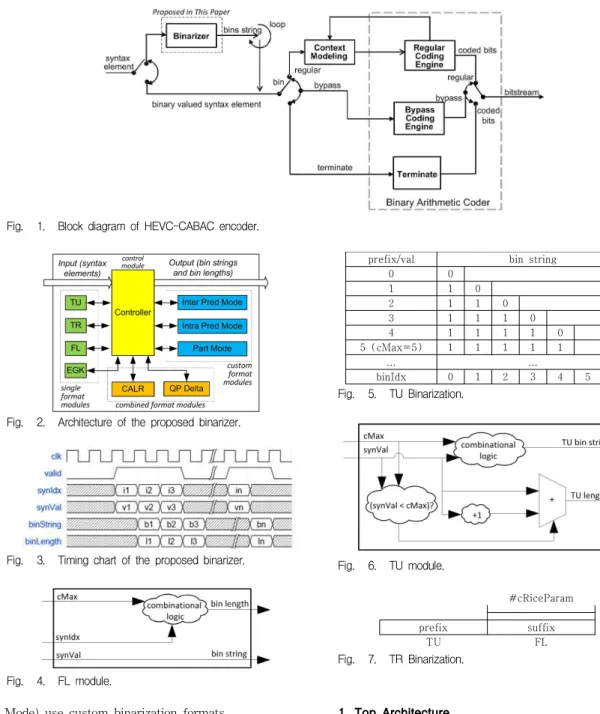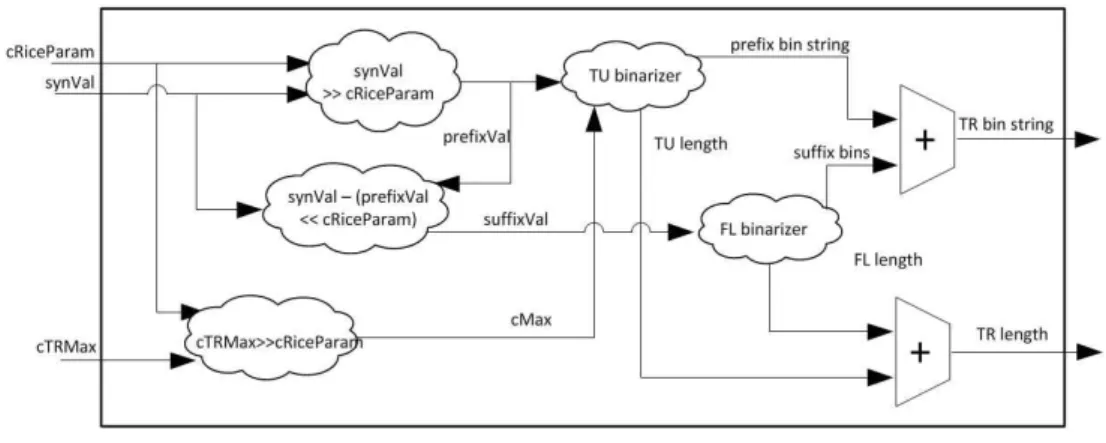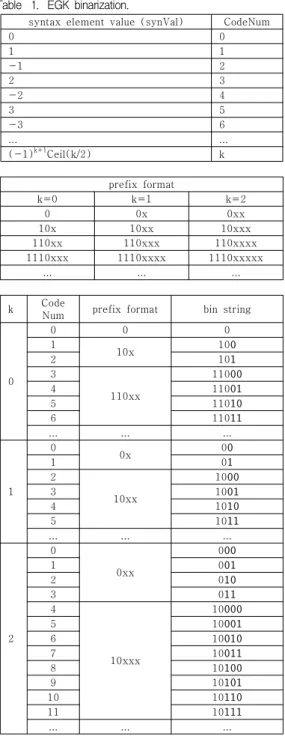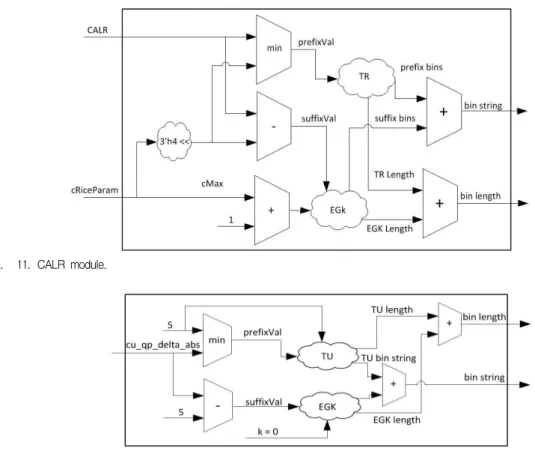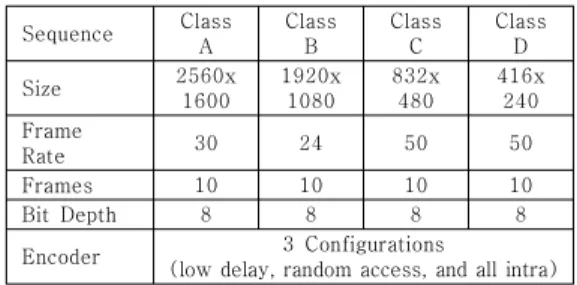Hardware Implementation of HEVC CABAC Binarizer
Duyen Hai Pham
*, Jeonhak Moon
*, Seongsoo Lee
*★Abstract
This paper proposes hardware architecture of HEVC (high efficiency video coding) CABAC (context-based adaptive binary arithmetic coding) binarizer. The proposed binarizer was designed and implemented as an independent module that can be integrated into HEVC CABAC encoder. It generates each bin string of each syntax element in a single cycle. It consists of controller module, TU (truncated unary binarization) module, TR (truncated Rice binarization) module, FL (fixed length binarization) module, EGK (k-th order exp-Golomb coding) module, CALR (coeff_abs_level_remaining) module, QP Delta (cu_qp_delta_abs) module, Intra Pred (intra_chroma_
pred_mode) module, Inter Pred (inter_pred_idc) module, and Part Mode (part_mode) module. The proposed binarizer was designed in Verilog HDL, and it was implemented in 45 nm technology. Its operating speed, gate count, and power consumption are 200 MHz, 1,678 gates, and 50 uW, respectively.
Key words: HEVC, CABAC, binarizer, hardware, implementation
* School of Electronic Engineering, Soongsil University, sslee@ssu.ac.kr, 010-9182-3835
★
Corresponding author
※ Acknowledgment
“This research was supported by Basic Science Research Program through the National Research Foundation of Korea(NRF) funded by the Ministry of Education, Science and Technology(2010-0025041)”
Manuscript received Sep. 15, 2014; revised Sep. 18, 2014; accepted Sep. 19. 2014
I. Introduction
HEVC (high-efficiency video coding) [1]-[4] is the next-generation international standard of video codec succeeding H.264/AVC (advanced video coding). This standard delivers the same quality as H.264/AVC at close to 50% of the bitrate, has ability to support higher resolutions reach 8K. It achieves better quality with reduced bandwidth costs, which enables to deliver HD (high definition) or UHD (ultra high definition) contents to mobile devices over limited bandwidth.
CABAC (context-based adaptive binary arithmetic coding) is an entropy coding technique used in H.264/AVC and also in HEVC with high coding efficiency. It performs three main functions:
binarization, context modeling, and arithmetic coding, describes as the Fig. 1. Binarization generates binary symbol, called as bin, from the syntax elements. Context modeling calculates the probability of the each bin based on the neighboring information and last coded bins. Finally, binary arithmetic encoding compresses the bins into bits based on the estimated probability.
Binarizer is one of core blocks in CABAC encoder. This paper proposes the architecture of binarizer for HEVC CABAC encoder. It was designed in Verilog HDL and was implemented in 45 nm technology.
II. Hardware Architecture
HEVC CABAC binarization has several basic binarization formats such as unary (U), truncated unary (TU), truncated Rice (TR), kth-order Exp-Golomb (EGK), and fixed length (FL). Almost all syntax elements exploit these basic binarization formats, but some syntax elements such as coeff_abs_level_remaining (CALR) and cu_qp_delta_
abs (QP Delta) exploit two or more combinations of basic binarization. Some syntax elements such as inter_pred_idc (Inter Pred Mode), intra_chroma_
pred_mode (Intra Pred Mode), and part_mode (Part
60 j.inst.Korean.electr.electron.eng.Vol.18,No.3,356∼361,September 2014
Fig. 1. Block diagram of HEVC-CABAC encoder.
Fig. 2. Architecture of the proposed binarizer.
Fig. 3. Timing chart of the proposed binarizer.
Fig. 4. FL module.
prefix/val bin string
0 0
1 1 0
2 1 1 0
3 1 1 1 0
4 1 1 1 1 0
5 (cMax=5) 1 1 1 1 1
... ...
binIdx 0 1 2 3 4 5 6
Fig. 5. TU Binarization.
Fig. 6. TU module.
#cRiceParam
prefix suffix
TU FL
Fig. 7. TR Binarization.
Mode) use custom binarization formats.
Comparing with H.264/AVC, the basic binarization formats are almost same, but combination and custom binarization processes are different. The proposed binarizer supports all the basic and custom binarization format in HEVC. It gets syntax element as an input and puts a bin string as an output.
1. Top Architecture
The proposed binarizer consists of four groups of
submodules such as controller module, single format
modules, combined format modules, and custom
format modules. Its inputs are synVal and synIdx
which determine the specific binarization process for
corresponding syntax element. Its outputs are bin
Fig. 8. TR module.
string and bin length of each syntax element.
The controller module gets the synVal and synIdx from peripheral bus. It categorizes the type of binarization format of each syntax element based on synIdx and assigns it to corresponding submodule.
Single format modules are TU, TR, FL, and EGK modules, which process their corresponding single binarization formats. Combined format modules are CALR (coeff_abs_level_remaining) and QP Delta (cu_qp_delta_abs) modules, which invoke single format modules and process their corresponding combined binarization formats.
Cunstom format modules are Inter Pred Mode (inter_pred_idc), Intra Pred Mode (intra_chroma_
pred_mode), and Part Mode (part_mode) modules.
They process custom binarization formats, and they are implemented as look-up tables.
The hardware architecture of the proposed binarizer is shown in Fig. 2. Its latency is one cycle, as shown in the timing chart of Fig. 3.
2. FL Module
Fixed length binarization is performed by using a fixed length unsigned integer bin string which represents a binary value of syntax element value.
The length of bin string is equal to Ceil(Log2(cMax+1). Bin string starts from most significant bit (MSB) to least significant bit (LSB).
FL module is designed as shown in Fig. 4.
3. TU Module
Truncated unary binarization is a reduction form of unary scheme which generates a bin string of
"1" and follow a terminating "0" bit at the end of bin string for the case of synVal < cMax. If the synVal reaches to cMax, terminating "0" is not presented in the TU bin string. The length is calculated from synVal + 1 (or synVal when synVal equals to cMax). Fig. 5 explains TU binarization.
TU module is designed as shown in Fig. 6.
4. TR Module
Truncated Rice binarization consists of two parts, i.e. prefix and suffix (when it present) bin string.
The prefix part invokes TU binarization. The suffix part invokes FL binarization as shown in Fig. 7.
The length of suffix part is equal to the value of cRiceParam. prefixVal = synVal>>cRiceParam and suffixVal=synVal−((prefixVal)<<cRiceParam). When cRiceParam=0, TR binarization becomes TU binarization. TR binarization is used in CALR syntax element for prefix bin string. TR module is designed as shown in Fig. 8.
5. EGK Module
k-th Exp-Golomb binarization is variable length
codes. The bin length of code words increases
exponentially with their value. Each codeword
consists of prefix and suffix parts. This codeword
is lead by N bit separators of "1" or "0", and it is
followed by N bit suffix codewords which contains
information.
62 j.inst.Korean.electr.electron.eng.Vol.18,No.3,356∼361,September 2014
syntax element value (synVal) CodeNum
0 0
1 1
-1 2
2 3
-2 4
3 5
-3 6
... ...
(-1)k+1Ceil(k/2) k
prefix format
k=0 k=1 k=2
0 0x 0xx
10x 10xx 10xxx
110xx 110xxx 110xxxx
1110xxx 1110xxxx 1110xxxxx
... ... ...
k Code
Num prefix format bin string
0
0 0 0
1 10x 100
2 101
3
110xx
11000
4 11001
5 11010
6 11011
... ... ...
1
0 0x 00
1 01
2
10xx
1000
3 1001
4 1010
5 1011
... ... ...
2 0
0xx
000
1 001
2 010
3 011
4
10xxx
10000
5 10001
6 10010
7 10011
8 10100
9 10101
10 10110
11 10111
... ... ...
Table 1. EGK binarization.
Fig. 9. MSB position logic in EGK module.
Fig. 10. EGK module.
EGK binarization represents signed number as shown in Table 1. synVal is divided into two parts by the k-order variable. prefixVal is added by one and after that using MSB position logic detects the most significant one bit existed in the prefixVal
which is used to determine the number of "1" bins for prefix bin string. Suffix bins represented by suffixVal added at the end of bin string.
MSB position logic is designed as shown in Fig.
9. Index variable indicates the highest position of sub-string contains "1" bit, the range is 0, 4, 8, 12.
An offset variable indicates the position of "1"
present in the sub-string with the range from 0..3.
N position is the sum of index and offset. N is also used to calculated the length of EGK bin string.
EGK module is designed as shown in Fig. 10.
Fig. 11. CALR module.
Fig. 12. QP Delta module.
6. CALR Module
CALR module invokes TR binarization and EGK binarization for generating bin string. prefixVal=Min(
cMax, coeff_abs_level_remaining[n]) and suffixVal=
coeff_abs_level_remaining[n]-cMax. CALR module is designed as shown in Fig. 11.
7. QP Delta Module
The bin string is a concatenation of a prefix bin string and a suffix bin string (when it present).
prefixVal=Min(cu_qp_delta_abs, 5) which will invoke the TU binarzation with cMax=5. suffixVal=
cu_qp_delta_abs−5. It invoke the EGK binarization with 0th k-order. QP Delta module is designed as shown in Fig. 12.
8. Lookup Tables for Intra Pred Module, Inter Pred Module, and Part Mode Module
Intra Pred module, Inter Pred module, and Part Mode module can be easily designed with lookup tables [1].
III. Experiments and Results The proposed binarizer was designed in Verilog HDL. It was simulated and verified using 12 test vectors, i.e. 4 standard test sequences (class A, B, C, and D) with 3 encoder configurations (low delay, random access, and all intra) as shown in Table 2.
It has passed in all tests.
The designed binarizer was implemented in 45
nm technology. CAD tool was supported by IC
Design Education Center (IDEC). As shown in
Table 3, its operating speed, gate count, and power
consumption are 200 MHz, 1,678 gates, and 50 uW,
respectively. Its critical path delay is 4.763 ns. The
latency of the designed binarizer is only one cycle.
64 j.inst.Korean.electr.electron.eng.Vol.18,No.3,356∼361,September 2014
Sequence Class A
Class B
Class C
Class D
Size 2560x
1600
1920x 1080
832x 480
416x 240 Frame
Rate 30 24 50 50
Frames 10 10 10 10
Bit Depth 8 8 8 8
Encoder 3 Configurations
(low delay, random access, and all intra)
Technology 45nm
Operating Frequency 200 MHz Gate Counts 1,678 gates Critical Path Delay 4.763 ns Dynamic Power 50 uW Leakage Power 3.25 uW
